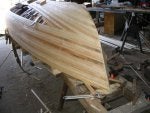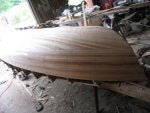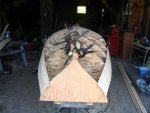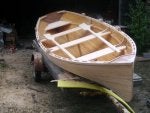Can I make beehives from 1x4 lumber with the same structural integrity as the normal 1x12 or close? The reason for this is to save money. At my local Menards a 6ft 1x12 cost $15.36 while 6ft 1x4 cost 1.99, this means I could purchase the necessary lumber for 1 deep box for $6. I was thinking I could stagger the joints on the sides and ends so everything is well attached. Has anyone ever done this before?

Can I make hives out of 1x4 lumber?
David6272
41 - 60 of 63 Posts
Yes, I like doing projects for people with sawmill lumber. My son married a little gal from the big toe in southern Virginia. Their farm is in a beautiful valley. Her father built every building on it! He was showing me around and I noticed an old wooden corncrib. It was filled with old, weathered sawmill lumber! I got excited about it! The next thing I knew my son came back to our little place with a pickup load of it. It is a mix of different woods. There was even several pieces of wormy Chestnut!
He has brought me two more loads since. I love working with it but some is so hardened it dulls my planer blades easily.
Rough cut, solar kiln. Those boards pictured have been sitting since last spring.Are they kiln dried or air stacked? Are they sanded and edged? I use sawmill lumber often, but have not used for bee boxes.
So the answer to the op is yes.
The ones I get are ruff sawed, but $6 for a 1x12x10 makes it worth my time to finish then to what I need. If they are green, I will let them air dry for a couple of weeks, then finish them to the size I need. There is no need to have them kilm dried as they are being outside.Are they kiln dried or air stacked? Are they sanded and edged? I use sawmill lumber often, but have not used for bee boxes.
being used outsideThe ones I get are ruff sawed, but $6 for a 1x12x10 makes it worth my time to finish then to what I need. If they are green, I will let them air dry for a couple of weeks, then finish them to the size I need. There is no need to have them kilm dried as they are being outside.
Well, wood will move through expansion and contraction. Green wood especially will move according to its grain. The moisture will cause it to "spring" as it releases from pressure. I have actually had stair runners do this after they are notched. They were kiln dried but stored in open buildings at the lumber yards.The ones I get are ruff sawed, but $6 for a 1x12x10 makes it worth my time to finish then to what I need. If they are green, I will let them air dry for a couple of weeks, then finish them to the size I need. There is no need to have them kilm dried as they are being outside.
Don't get me wrong, I have built with sawmill hardwoods before. The siding I hung vertically shrank and warped making the board and batten more like crooked wood partially battened. This was many years ago before the advent of metal siding. At least if it happens in hives the bees normally propolize gaps.
Joined
·
10,899 Posts
Kiln dried is a very broad term unless percentage moisture is also specified. Reading the grain orientation gets quite important especially as board width increases. Type of joint affects the importance of flatness of your boards.
If you plane boards that have only been recently sawn you best get them nailed in place before they start to cup.
Most of this can be disregarded in the OP's proposal as the pieces are narrow and probably dried enough to be stable.
If I was hard up against financial constraints I would use the narrow boards and make them quick and dirty. You cannot make a silk purse out of a sows ear! @little_john would be familiar with that analogy.
Depending on what you are doing with them, narrow boards can be your friend!
Just for some wood porn below is Miss Fit! We spent a lot of hours together!
These came entirely from home sawn white and red pine logs.
If you plane boards that have only been recently sawn you best get them nailed in place before they start to cup.
Most of this can be disregarded in the OP's proposal as the pieces are narrow and probably dried enough to be stable.
If I was hard up against financial constraints I would use the narrow boards and make them quick and dirty. You cannot make a silk purse out of a sows ear! @little_john would be familiar with that analogy.
Depending on what you are doing with them, narrow boards can be your friend!
Just for some wood porn below is Miss Fit! We spent a lot of hours together!
These came entirely from home sawn white and red pine logs.
Attachments
-
66.2 KB Views: 1
-
65.3 KB Views: 8
-
54.7 KB Views: 1
-
63.2 KB Views: 1
-
29.6 KB Views: 1
-
71.6 KB Views: 1
Joined
·
1,576 Posts
Using biscuits was mentioned. You can also use wood pins. Make a template to drill the holes for the dowels to be exact spacing for each joined narrow board. Predrill, use an exterior glue (titebond III) to glue dowels and entire length of combined board length. Clamp together and voila! A solid board of wider dimension. Then cut these to length, width and router the frame rest and corner joints if wanting that corner connection. I'd just butt joint them.
Your mock up of corner joints is overthought out and really will not provide a longer lasting or stronger connection. Top quality exterior wood glue and screws or long staples will be just as strong. A rabbit joint simply hides most of the wood end grain and does not actually provide more support. It does aid in squaring up the box. If you have a router set up and it won't take any time then sure, they are nice to have. Otherwise just butt joint them and ensure the exposed end grain is properly sealed. Brushing on the exterior glue to the exposed end grain works if you don't have faith in your finish paint, stain or whatever you are doing. The rabbit for frame rest can be done on a table saw if you don't have a router. Once that is set up I run long boards through, my hand router is set for frame rests and use that full length board, then cut them to length needed for the size box being made.
Your mock up of corner joints is overthought out and really will not provide a longer lasting or stronger connection. Top quality exterior wood glue and screws or long staples will be just as strong. A rabbit joint simply hides most of the wood end grain and does not actually provide more support. It does aid in squaring up the box. If you have a router set up and it won't take any time then sure, they are nice to have. Otherwise just butt joint them and ensure the exposed end grain is properly sealed. Brushing on the exterior glue to the exposed end grain works if you don't have faith in your finish paint, stain or whatever you are doing. The rabbit for frame rest can be done on a table saw if you don't have a router. Once that is set up I run long boards through, my hand router is set for frame rests and use that full length board, then cut them to length needed for the size box being made.
I would not.Can I make beehives from 1x4 lumber with the same structural integrity as the normal 1x12 or close? The reason for this is to save money. At my local Menards a 6ft 1x12 cost $15.36 while 6ft 1x4 cost 1.99, this means I could purchase the necessary lumber for 1 deep box for $6. I was thinking I could stagger the joints on the sides and ends so everything is well attached. Has anyone ever done this before?
but I have all the wider wood I need.
the deep is 9 5/8 the rip off the 12 can be the rim for the lid.
the 1/4s can be glued and caulked then painted.
IMO for the work buy the wider wood up front.
Very pretty, congratulations. I was pointing to possible problems in using green wood and not mandating their use or non use. Freedom of choice is exactly that: freedom. I too have used narrow boards for many things, and some of those resulted in being contacted to build for others and being paid handsomely for it. As a point of contention it is a non starter. As a reference to possible ramifications I could offer more first hand examples simply from experience. Many people use pallet wood for projects and some of those are quite attractive. That too is a taste consideration. As for bee hives themselves another consideration is that many of these pallets have been treated with various substances for longevity. That would be my best judgment on whether or not to use them without implying any advice for or against. Discussion can run off the rails when implications of motive are brought without evidence or justification.Kiln dried is a very broad term unless percentage moisture is also specified. Reading the grain orientation gets quite important especially as board width increases. Type of joint affects the importance of flatness of your boards.
If you plane boards that have only been recently sawn you best get them nailed in place before they start to cup.
Most of this can be disregarded in the OP's proposal as the pieces are narrow and probably dried enough to be stable.
If I was hard up against financial constraints I would use the narrow boards and make them quick and dirty. You cannot make a silk purse out of a sows ear! @little_john would be familiar with that analogy.
Depending on what you are doing with them, narrow boards can be your friend!
Just for some wood porn below is Miss Fit! We spent a lot of hours together!
These came entirely from home sawn white and red pine logs.
So, returning to the original inquiry in order to submit opinions for the record, my advice within the context of the question is the original affirmative. Craftsmen of any skill level are free to indulge their choices and take joy in so doing.
I will leave the Discussion at that and withdraw from any additions without emotion or provocation.
Have a wonderful day!
Joined
·
2 Posts
I made twenty hives a few years ago. It was a headache finding lumber that reasonably straight. Even then, they need to be run through the miter saw twice, the jointer, and the table saw. Then there's the dado stack and building a jig for the box joints. In the end it's cheaper/easier to just buy them unassembled.Can I make beehives from 1x4 lumber with the same structural integrity as the normal 1x12 or close? The reason for this is to save money. At my local Menards a 6ft 1x12 cost $15.36 while 6ft 1x4 cost 1.99, this means I could purchase the necessary lumber for 1 deep box for $6. I was thinking I could stagger the joints on the sides and ends so everything is well attached. Has anyone ever done this before?
To use 1x4's you'd have those problems and the added issue of aligning and gluing them to get a 1x11. If you like the satisfaction of DIY, go for it. There's no reason it wouldn't work.
Hi there,
I made a beehive van 2by4 some years ago. Still works pretty fine Good luck with your project!
Good luck with your project!
I made a beehive van 2by4 some years ago. Still works pretty fine
For many people their time is of no value.I made twenty hives a few years ago. It was a headache finding lumber that reasonably straight. Even then, they need to be run through the miter saw twice, the jointer, and the table saw. Then there's the dado stack and building a jig for the box joints. In the end it's cheaper/easier to just buy them unassembled.
To use 1x4's you'd have those problems and the added issue of aligning and gluing them to get a 1x11. If you like the satisfaction of DIY, go for it. There's no reason it wouldn't work.
If they spend it commenting in online forums or watching reruns of Gilligan's Island or watching the talking hair in their favorite news tunnel, it accomplishes nothing.
So for those people it make sense to do something constructive and useful, even if the value of that useful thing is small.
Not that all leisure is pointless, but leisure is like food. Most Americans have access to too much.
So now I need to apply my own medicine!
Joined
·
2 Posts
I agree with everything you said. I laser engrave all my hive boxes. It's takes a lot of time and doesn't provide any functional value (maybe theft prevention). I like it though and it gets attention from potential customers.For many people their time is of no value.
If they spend it commenting in online forums or watching reruns of Gilligan's Island or watching the talking hair in their favorite news tunnel, it accomplishes nothing.
So for those people it make sense to do something constructive and useful, even if the value of that useful thing is small.
Not that all leisure is pointless, but leisure is like food. Most Americans have access to too much.
So now I need to apply my own medicine!
The OP stated it was to save money. If that's the point of the exercise, then it doesn't hurt to see what the process looks like and consider whether it's worth the effort. Even for a leisure activity, it's costly to build hive boxes unless one already has the necessary equipment to do it right.
I've done it the easy way (few tools) and the right way (right tools). I'll never do either again
Anyone interested in saving a buck on beekeeping equipment should find a local beekeeping conference to attend. The vendors are motivated to get the prices down. Last year a vendor at MSU was selling deep hive bodies for less than I could buy the lumber. They are very high quality too.
I have an amazing array of mostly well used tools which I purchased in order to build or repair.I agree with everything you said. I laser engrave all my hive boxes. It's takes a lot of time and doesn't provide any functional value (maybe theft prevention). I like it though and it gets attention from potential customers.
The OP stated it was to save money. If that's the point of the exercise, then it doesn't hurt to see what the process looks like and consider whether it's worth the effort. Even for a leisure activity, it's costly to build hive boxes unless one already has the necessary equipment to do it right.
A deep 10 frame box is $24 from dadant. Add to that shipping and you still need to assemble it.
I got my table saw used for $175. It is a good saw.
It has paid for itself.
Having the tools to build pretty much anything allows me to experiment and try different things.
All work produces a profit, but mere talk leads only to poverty.
Important safety tip: when using a table saw, fear the blade, use the safety features, and pay attention to what you are doing. One trip to the emergency room will devour any savings you hope to realize.
It's interesting the price of a 10 frame deep box that is. Last night I was talking with my Amish neighbor. He (Josiah) had stopped over to pickup business cards I had ordered for this lamb business. We got to talking about building deep boxes. I had mentioned 25-30$ for a single deep box. But if he was going to get into building boxes he needs to find a wholesale outlet and be pricing his boxes in the 15$ range per 1000. We do have another Amish family that mills lumber he could source his lumber from. I'm thinking that Josiah would have to buy his lumber for about a $ per board foot to make a decent profit. Josiah is constructing a cabinet shop at home. So the equipment he'll need he has already. He would have to make some jigs to reduce labor etc.. We talked further about the construction using finger/box joints etc. A couple years ago I bought boxes from an Amish guy up north and wasn't all that impressed with the construction of the box. This guy used a dado joint and nails. And I told Josiah that. This morning I went on 3 different websites to price volume purchases of deep boxes and found the best price at 16$ when purchasing 250 boxes. So if he can get the production time down to 5 minutes. Josiah could be making 120$ per hour. Not bad for a kid in his early twenties and three feet tall. Kind of funny watching a skid-steer drive by with no driver.
Be aware that to be competitive in the production of the box joints, the machine should cut both ends to width AND cut all notches in one pass. It is a huge machine, with stackable knives on two spindles, and a huge motor.
Psycho Roland.
Psycho Roland.
A double-ended tenoner.
Though the initial cut to length is typically done with a cut-off or "chop" saw.
Many years ago, I worked in the Marvin's Windows plant in Warroad Minnesota.
They had a lot of large machines. Green painted cast iron. Tailing the molding machines was my least-favorite assignment. Stacking sticks as fast as humanly possible.
Motivated me to get an education.
Though the initial cut to length is typically done with a cut-off or "chop" saw.
Many years ago, I worked in the Marvin's Windows plant in Warroad Minnesota.
They had a lot of large machines. Green painted cast iron. Tailing the molding machines was my least-favorite assignment. Stacking sticks as fast as humanly possible.
Motivated me to get an education.
A. Novice - the blank is purposely cut oversize, so that the depth of the box fingers are not effected by the cut length. The stagger in cutter diameters determines the depth.
Psycho Roland
Psycho Roland
Correct.A. Novice - the blank is purposely cut oversize, so that the depth of the box fingers are not effected by the cut length. The stagger in cutter diameters determines the depth.
Psycho Roland
The blank is also not very precise. The entire end is cut by the big machine like you said.
It makes a lot of sawdust. And noise.
41 - 60 of 63 Posts
-
?
-
?
-
?
-
?
-
?
-
?
-
?
-
?
-
?
-
?
-
?
-
?
-
?
-
?
-
?
-
?
-
?
-
?
-
?
-
?
- posts
- 1.9M
- members
- 62K
- Since
- 1999
A forum community dedicated to beekeeping, bee owners and enthusiasts. Come join the discussion about breeding, honey production, health, behavior, hives, housing, adopting, care, classifieds, and more!
Our Vendors
View AllTop Contributors this Month
View All
Snarge
241 Replies
velacreations
186 Replies
A Novice
153 Replies









